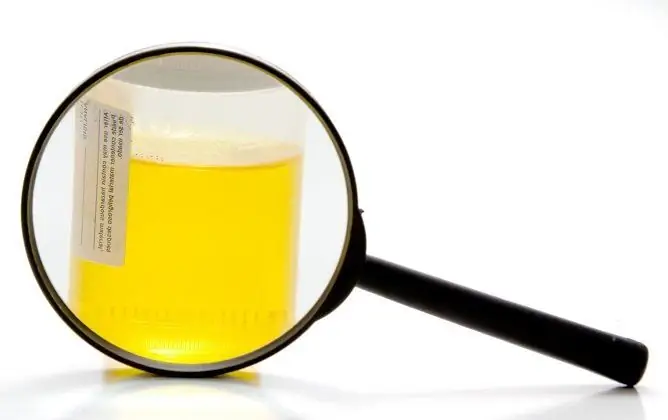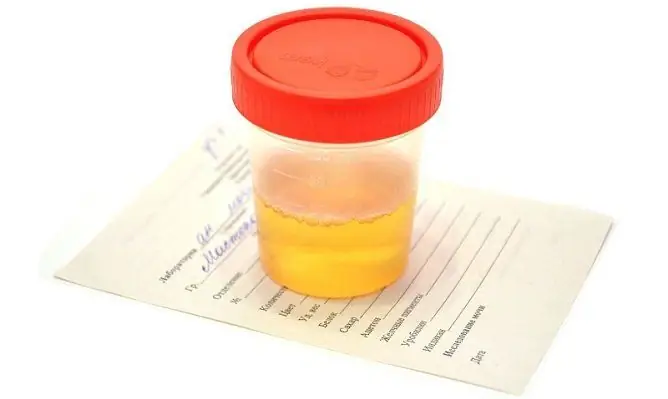- Author Rachel Wainwright [email protected].
- Public 2023-12-15 07:39.
- Last modified 2025-11-02 20:14.
How to take a urine test correctly: preparation, collection
The content of the article:
- Analysis preparation rules
- Urine tests
-
How to collect urine for different tests
- General urine analysis
- Analysis according to Nechiporenko
- Daily urine analysis
- Zimnitsky test
- Urine sugar test
- Urinalysis by PCR
- Bacteriological analysis of urine
- Sulkovich urine analysis
- Urinalysis for oxalate
- Diastasis analysis
- Urinalysis for cortisol
- Deviation of indicators from the norm
Before taking the analysis, it is advisable to consult with the prescribing doctor, who will explain in detail how to take a urine test correctly.

In order for the urine analysis to show a reliable result, the material must be collected in compliance with all the rules
To get the most reliable analysis result, you should adhere to the rules for the preparation and collection of material, as well as its delivery to the laboratory.
Analysis preparation rules
It is undesirable (allowed if there is an urgent need) to take urine for analysis:
- within a week after cystoscopy or urethroscopy;
- during acute respiratory or other diseases, accompanied by an increase in temperature;
- during menstruation.
If it is necessary to pass urine for analysis, women during menstruation are advised to use a hygienic swab to avoid getting menstrual flow into the collected material. If you don't have a hygienic tampon, you can make one with cotton or gauze.
The day before the study follows:
- refrain from sexual intercourse;
- avoid excessive physical and psycho-emotional stress;
- do not drink alcohol;
- do not drink mineral water;
- exclude from the diet fruits and vegetables that can stain urine (cranberries, beets, carrots);
- do not take vitamin preparations;
- agree with the attending physician on the possibility of taking medications or the need to withdraw them.
Before taking the test, it is not recommended to consume more or less fluids than usual and change your eating habits, with the exception of the specified restrictions.

It is advisable to collect urine for analysis in a special container, which can be purchased at the pharmacy
Prepare a container to collect urine in advance. It is advisable to use disposable plastic containers specially designed for this. They can be purchased at the pharmacy, and in some laboratories they are issued to the patient when registering for the study. In the absence of a special container, you can use a previously thoroughly washed and sterilized glass jar with a tight lid (household plastic containers are not suitable for this purpose).
In different laboratories, the conditions for the preparation and delivery of the material may differ, including it should be borne in mind that a number of laboratories do not accept material for research in any other container, except for a special container, so it is advisable to inquire in advance about the rules for taking urine for analysis in the laboratory where give up analysis.
Before collecting urine, it is necessary to conduct a toilet of the external genital organs, however, it is not recommended to use antibacterial soap for this purpose. When filling the container, do not touch the genitals with it.
Collecting urine for analysis in adults is usually not difficult, but in young children it can be difficult. For infants, special urine bags are sold in pharmacies, which greatly facilitate the task.
With improper preparation and delivery of urine, the results of the analysis are distorted, which necessitates a second study, and in some cases can lead to diagnostic errors.
Urine tests
Urine is a biological fluid that is produced by the kidneys during blood filtration and removes the excess filtered substances from the body. The volume of urine excreted per day is called daily urine output.
A general analysis of urine makes it possible to assess the state of human health, clarify the diagnosis, and also monitor the course of treatment. In addition, urinalysis should be taken regularly for women during pregnancy. A general urine test for pregnant women is carried out regularly until delivery, since it allows you to identify the development of various types of pathologies and take the necessary measures in a timely manner.
Urine analysis according to Nechiporenko is prescribed if there is a suspicion of the presence of an infectious and inflammatory process in the urinary tract. With its help, it is possible to identify a latent inflammatory process, hematuria, cylindruria.
Daily urine is used for laboratory analysis for protein, creatinine, urea, etc. To determine disorders of the pituitary and adrenal glands, a cortisol test is prescribed. It is performed on suspicion of Itsenko-Cushing's syndrome, adrenogenital syndrome and other hormonal disorders.
A urine test according to Zimnitsky is usually prescribed if there is a suspicion of an inflammatory process in the kidneys or urolithiasis.
The Sulkovich analysis is the determination of the level of calcium in the urine. It is often used in pediatrics to determine urinary calcium excretion during the monitoring of vitamin D therapy (including the selection of the correct dose of the drug).
Analysis of urine for diastasis allows you to detect disorders of the pancreas.
A urine drug test can be used to determine whether a person has taken drugs in the 2-5 days prior to the test. This method allows the detection of opiates, marijuana, cocaine, amphetamine, etc. in urine.

It is easier to collect urine for analysis in infants with a urine collection bag
How to collect urine for different tests
The methods of collecting urine differ depending on the type of examination.
General urine analysis
For general analysis, the first morning urine should be collected. In this case, the first portion of urine is released into the toilet, the rest of the material is collected in a prepared container. For this analysis, it is desirable to collect at least 70 ml.
Analysis according to Nechiporenko
For analysis according to the Nechiporenko method, an average portion of morning urine is collected. The beginning is the same as when collecting urine for a general analysis, except that not only the first but also the final portion is released into the toilet.
Daily urine analysis
For laboratory examination of daily urine, the first morning urine is not collected, however, the time of urination is noted. All the rest of the urine for that day and the first morning of the next day is collected in a specially designed graduated container with a volume of 2.7 liters (sold in a pharmacy) or a three-liter jar washed and sterilized with steam. Collect urine directly into the container, closing it tightly after each urination. The container should be stored in a cool place (for example, on the bottom shelf of the refrigerator) during the entire collection of the material, away from freezing.
All collected urine can be delivered to the laboratory, or, after mixing thoroughly, pour into a small container 100-150 ml. In the latter case, the amount of collected daily urine must be recorded and reported to the laboratory assistant.
Zimnitsky test
To carry out the analysis according to Zimnitsky, daily urine is also required, however, it is not collected in one container, but separately eight portions of urine are collected approximately every three hours (the first morning urine is removed, but the first morning urine of the next day is collected). Each portion of the material is collected in a separate container, which indicates the time of urination. If three hours after the previous urination there is no desire to urinate, the container is left empty, noting the time. If there is a need to urinate earlier than three hours and more than eight portions of urine are obtained, fill an additional container, marking the time.
Urine sugar test
For the analysis for sugar (determination of the level of glucose in the urine), three portions of urine collected per day are delivered to the laboratory at intervals of 8 hours, while the 1st portion is collected from 08:00 to 16:00, the 2nd - from 16: 00 to 24:00, and the 3rd - from 00:00 to 08:00.
Urinalysis by PCR
Urine for research by the polymerase chain reaction method (for example, for the purpose of detecting cytomegalovirus, mycobacterium tuberculosis, sexually transmitted infections) is collected in the morning on an empty stomach, at least two hours should pass since the last urination. The material for analysis is collected in a sterile plastic container for collecting urine. This study requires at least 20 ml.
Bacteriological analysis of urine
For bacteriological research (urine for culture, urine for bacterial culture), the material, as well as in the analysis for PCR, is collected exclusively in a sterile container specially designed for this. Urine should be collected before starting antibiotic treatment and / or at least three days after completing it. If antibiotic therapy is not completed, it may be necessary to temporarily discontinue the drug, but this requires consultation with your doctor. For this study, the average portion of morning urine is collected, as for the analysis according to Nechiporenko.
Sulkovich urine analysis
For the analysis according to Sulkovich, morning urine collected on an empty stomach is necessary, 50 ml of an average portion of morning urine is enough.
Urinalysis for oxalate
For analysis for oxalates, 24-hour urine is collected as described above, then the container with the material is shaken and 100 ml is taken into a separate container, which is transported to the laboratory.
Diastasis analysis
Urine for diastasis analysis is collected in the morning in the same way as for general analysis. The material should be delivered to the laboratory no later than two hours after collection.
Urinalysis for cortisol
For the analysis of cortisol, daily urine is collected in a container with a preservative, which is issued in the laboratory. Biological material should be stored in a dark, cool place throughout collection. After receiving the last portion, you should determine the volume of urine, mix it, take 35-40 ml and deliver it to the laboratory within 1-1.5 hours.
Deviation of indicators from the norm
The normal volume of urine in one urination is approximately the same for women and men and is 100-300 ml. A decrease in urine output indicates dehydration or renal failure. The volume of urine exceeding the norm is characteristic of diabetes mellitus.
Normal urine color is light yellow. Its change allows one to suspect pathological processes in the body. For example, an orange-brown color may indicate liver disease, reddish - glomerulonephritis, urolithiasis, neoplasms of the urinary tract.

The color of urine changes in some diseases, under the influence of a number of medications or food
An increase in specific gravity (density) may indicate dehydration, a decrease - on kidney pathologies.
Urine is normally clear, clouding can be caused by protein, erythrocytes, microorganisms, salts, mucus, pus and other impurities.
Protein in the urine may indicate the presence of diseases of the organs of the urinary system; glucose and ketone bodies in urine are determined in diabetes mellitus.
Erythrocytes are found in pyelo- and glomerulonephritis, urolithiasis, infectious diseases, systemic diseases, and poisoning. The number of leukocytes in urine increases with pyelonephritis, glomerulonephritis, cystitis, urethritis, prostatitis.
Cylinders are found in urine with kidney disease, fever, heart failure, hypertension, and poisoning with heavy metal salts. Microorganisms - in infectious processes.
YouTube video related to the article:

Anna Aksenova Medical journalist About the author
Education: 2004-2007 "First Kiev Medical College" specialty "Laboratory Diagnostics".
Found a mistake in the text? Select it and press Ctrl + Enter.






